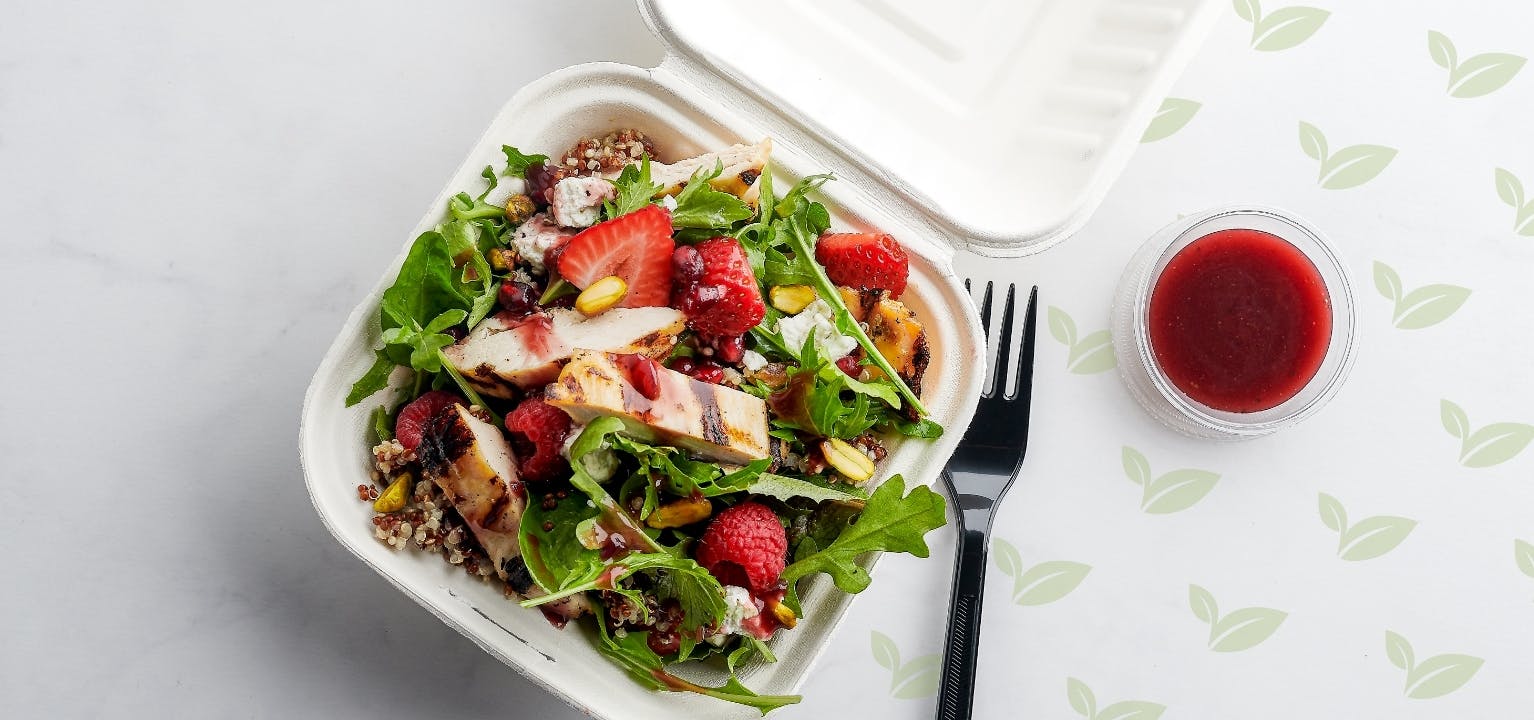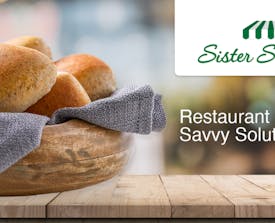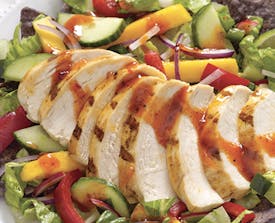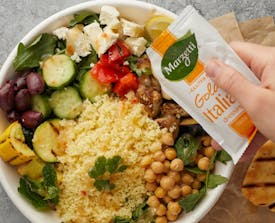
Boosting Off-Premise Sales
Operators can fill demand for healthful, off-premise meals and snacks with salads, grain bowls and other foods that go better with dressings and dips.
Whether it’s a quick bite on the go, a restaurant meal at home or a catered spread for a group of co-workers, off-premise dining is exploding. According to “Harnessing Technology to Drive Off-premises Sales,” a 2019 survey conducted by the National Restaurant Association, off-premise orders comprise 60 percent of foodservice occasions. Off-premise dining includes drive-thru, takeout and delivery, as well as freshly prepared items purchased at supermarkets and convenience stores. Also according to the survey, 92 percent of consumers use drive-thru at least once a month, and 34 percent of consumers use delivery more often than a year ago.
When it comes to off-premise sales, restaurant customers are looking for flavor and convenience. As a result, operators are streamlining order taking and making sure the menu items arrive at their destination at the right temperature, without losing any flavor. Foodservice establishments are also looking to generate off-premise sales by tapping into other popular trends such as nutritious dining, environmentally friendly packaging and customizable dishes. Salads, long regarded as a healthful, made-to-order alternative, address many of these consumer demands—particularly where off-premise business is concerned. In fact, according to Datassential in its “Condiments, Sauces & Dressings, December 2018” report, leaf salads are being consumed 2.5 times more frequently off-premise than on-premise.
Here are four ways to drive off-premise sales:
1. Appeal to the Health-Minded
Salads, bowls, appetizers and the classic delivery food, pizza, are popular menu items for off-premise dining. But while these foods can readily be promoted as being convenient, they also can be marketed as possessing such trendy attributes as clean-label ingredients, functionality and good-for-you superfoods.
“This increased interest in nutrition-related dining continues to grow
”
— Marcia Schurer, president of foodservice consultancy Culinary Connections in Chicago
Also growing, she said, is the marketing around the various health-related attributes. “We’re seeing a lot more branding and labeling that talks about how food is more nutrient dense.”
That could mean anything from signage or menu information touting salads as paleo, keto or gluten-free, to information highlighting ingredients as being organic or natural.
“You see all these introductions of foods with clean labels,” Schurer said. “People don’t want ingredients that they can’t recognize.”
2. Update Packaging
Packaging is key to off-premise dining, and operators are looking for containers that are environmentally friendly, leak proof and keep salads cold, grain bowls hot and appetizers crispy. Some of the latest innovations in off-premise packaging for salads include containers made with plant-based fibers, Bento boxes with compartments and compostable carriers and lids.
One new trend is offering salads in glass jars from vending machines. “Years ago, you could never sell salad in a vending machine,” Schurer said. “People didn’t think it would be fresh.” This latest generation of vending machines are located in transit hubs, co-working spaces and other locations, and consumers can return the jars to receive a discount on their next salad.
3. Keep Pace with Nontraditional Locations
While vending machines might be the hot, new way to grab a salad on the go, supermarkets have long been a source of competition for restaurant salad concepts. According to the Food Marketing Institute’s (FMI) “2019 Power of Foodservice at Retail Report,” 63 percent of consumers say they incorporate time-saving solutions at dinner, such as buying semi- or fully prepared items from grocery retailers. Speed is important, as 68 percent of shoppers say they are interested in ready-to-eat, grab-and-go foods. Second was grab-and-go, heat-and-eat foods, preferred by 63 percent of shoppers.
Schurer pointed out that nontraditional competitors also include clothing and other nonfood retailers. For example, the athletic clothing giant Lululemon recently opened a 20,000-square-foot store in Chicago, where customers can take yoga classes, purchase clothing, eat a power bowl or salad and grab a snack to go. Also, some department stores and clothing retailers are bringing back restaurants that compete for foodservice dollars.
4. Go Beyond Salads
Customization is one feature that makes salads appealing. From trendy new salad and bowl chains to fast-casual outlets to supermarkets, consumers can select ready-made or build-your-own meals with their choice of ingredients—including the dressing. The right dressing, in fact, can add a healthful, indulgent or even global flavor to the salad.
Dressing makes many foods better. Salads and grain bowls get a flavor boost from a variety of salad dressings. Fried appetizers go well with creamy dressings. Ranch dressing is a delicious dipping sauce for pizza.
For operators, one key to making off-premise dining convenient and customizable is to offer individual packets of dressing. The Marzetti® Simply Dressed® line of clean-label dressings is available in single-serve packets and cups, as well as in 32-ounce bottles and back-of-the-house gallons. The flavor lineup includes:
- Blue Cheese
- Italian Vinaigrette
- Caesar
- Ranch
- Honey Mustard
- Balsamic Vinaigrette
Delivery and to-go can fulfill consumers' desires for delicious, healthful meals or snacks that can be eaten on- or off-premises. Foodservice operators who make their salads available for takeout, delivery or grab and go can benefit from this booming off-premises trend, and keep their customers coming back.
Related Trends
-

Restaurant Labor Woes, Savvy Solutions
The restaurant industry has long faced workforce challenges. But the current labor shortage is particularly difficult.
Read Article -

Feature Clean-Label Ingredients To Drive Salad Sales
Operators who emphasize clean-label ingredients have the opportunity to make these leafy greens even more appealing while they drive sales.
Read Article -

Beyond Lettuce: How Salads Mean So Much More Today
Salads have evolved beyond just a plate of lettuce into warm salads, grain bowls and so much more.
Read Article


